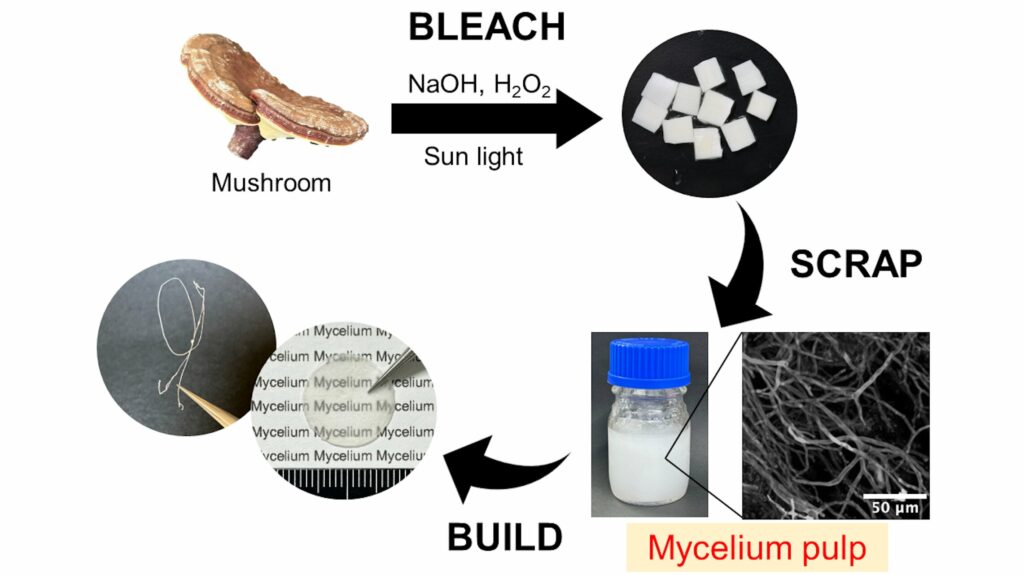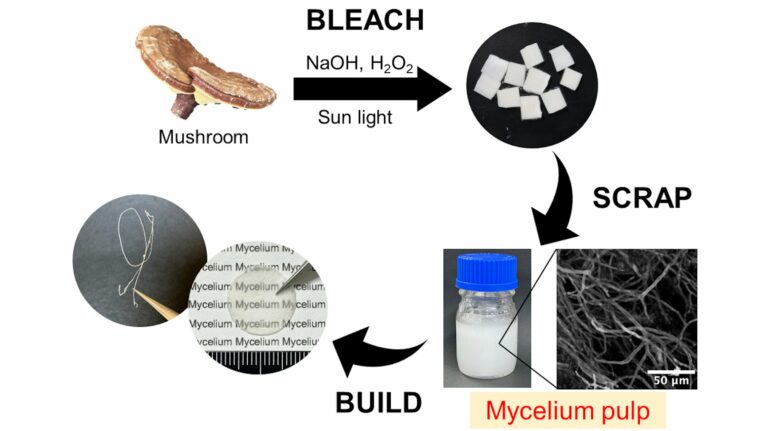An innovative approach to harvest mycelial fibers for the production of materials derived from mushrooms.
Mycelial fibers, present in the fibrous cells of mushroom fruiting bodies, are gaining traction as a sustainable material for crafting leather and packaging due to their remarkable formability. Recently, a research team from Shinshu University, Japan, has discovered an uncomplicated technique to acquire mycelial fibers, referred to as “mycelial pulp,” from mushroom fruiting bodies.
They successfully bleached these fibers using sunlight while preserving their mycelial structures. Each year, humans produce millions of tons of waste, with nearly 38% destined for landfills. A substantial portion comprises non-degradable plastic or petroleum-based materials, prompting scientists to seek environmentally friendly alternatives. Mushroom-based materials emerge as a promising renewable resource. The root-like structures, or mycelial fibers, exhibit potential as eco-friendly materials for various consumer and industrial applications.
These fibers, rich in proteins, chitin, and polysaccharides, prove ideal for crafting packaging, soundproofing, textiles, and more. Notably versatile, mycelial fibers have a minimal environmental impact, are biodegradable, and boast a cost-effective production process. However, traditional chemical or mechanical extraction methods often lead to undesirable discoloration and damage to the intricate mycelial structures, limiting their nanoscale applications. The recent ACS Sustainable Chemistry & Engineering paper presents a straightforward and efficient approach for obtaining mycelial pulp and fibers from mushrooms while preserving their structure, offering a green solution for sustainable material extraction.

Assistant Professor Satomi Tagawa from the Faculty of Engineering at Shinshu University, leading the study, emphasizes a shift in the perception of mushrooms from being primarily recognized as a food resource to becoming integral components of everyday household items.
This transition allows individuals to opt for products that prioritize safety, reliability, and environmental friendliness. Dr. Tagawa and her team, including Dr. Hiroya Nakauchi, recipient of the Research Fellowship for Young Scientists from the Japan Society for the Promotion of Science (JSPS), and Dr. Yoshihiko Amano, Professor at the Faculty of Engineering at Shinshu University, introduce an innovative method of extracting fibers that ensures the preservation of mycelial structures.
The researchers treated enoki and reishi mushrooms’ fruiting bodies with sodium hydroxide and hydrogen peroxide, followed by sunlight exposure to bleach or decolorize the obtained substances. The resulting white material underwent ultrasonic treatment to defibrillate the pulp at a mycelial level. This process yielded a dispersion containing micrometer-sized mycelium fibers with intact mycelial structures, confirmed through Fourier-transform infrared spectroscopy.
The fibers obtained through this procedure exhibited exceptional deformability, making them suitable for crafting various products, such as 3D porous sponges, 2D films, and 1D yarns. Beyond obtaining a versatile mushroom-based material, this straightforward approach contributes significantly to the scrap-and-build method for manufacturing mushroom materials, complementing existing bottom-up approaches. Dr. Tagawa envisions the technology as a means of upcycling by-products generated by the mushroom industry, enhancing the circularity and reusability of mushroom materials. She believes that further exploration of sustainable materials and methods could foster new industries, create job opportunities, and revitalize local communities.
This article is republished from PhysORG under a Creative Commons license. Read the original article.
Do not forget to share your opinion with us to provide you with the best posts !





0 Comments